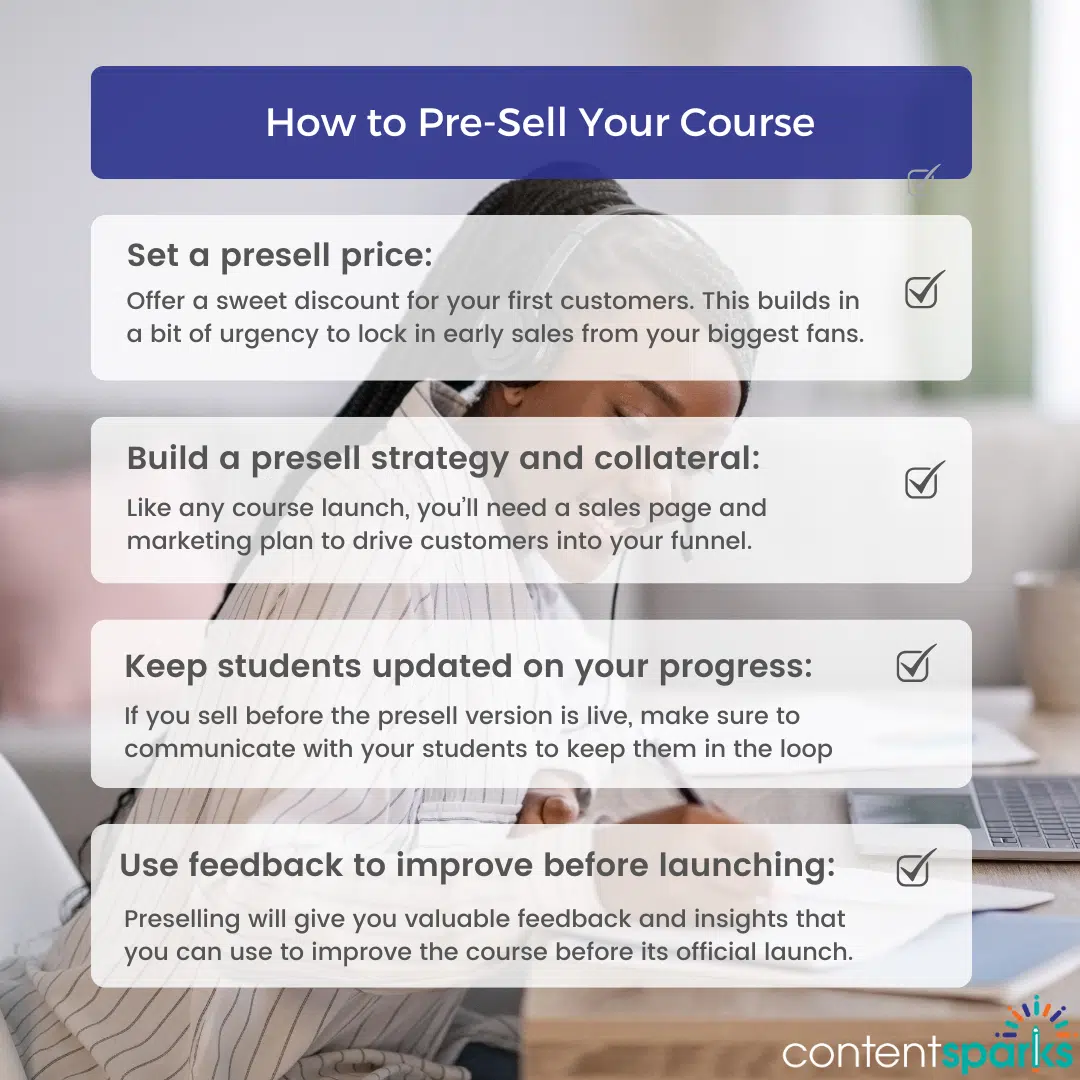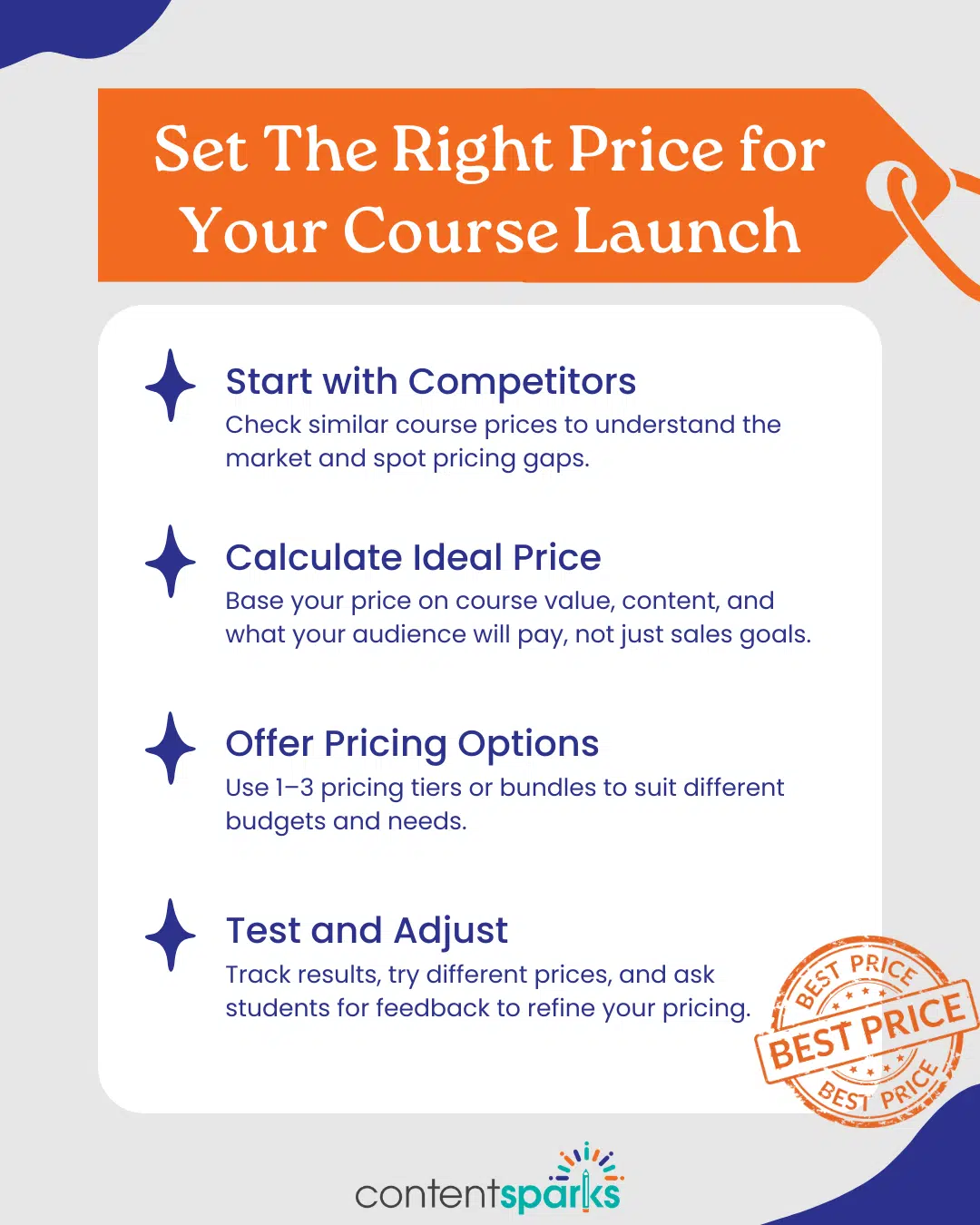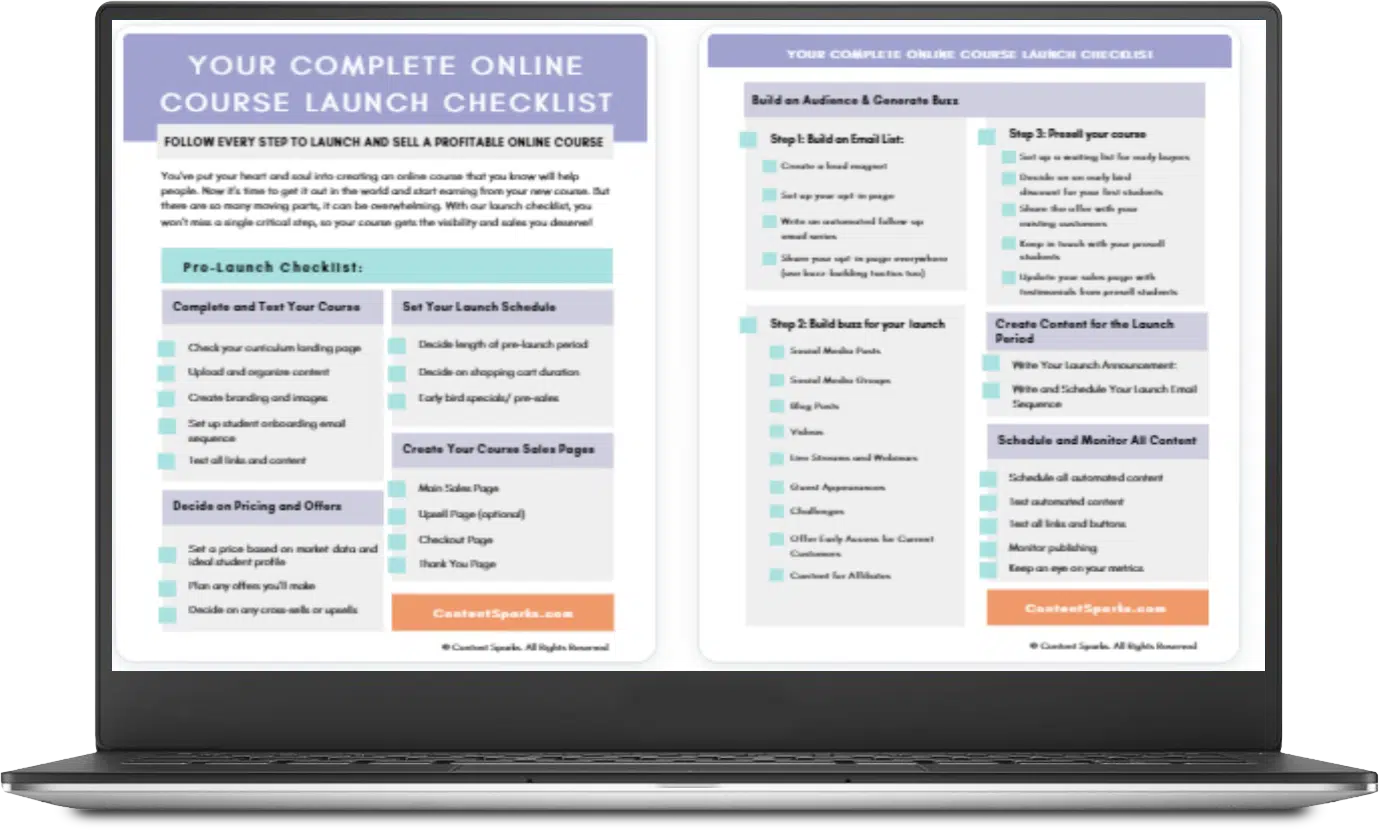No products in the cart.

How to Launch an Online Course [Step-by-Step Guide]
Maybe you’ve been dreaming of sharing your knowledge with thousands of people for a while now. Or perhaps you just dipped your toes into the waters of course creation.
Whatever your motivation, once you’ve put in all the work to create a course, you then get to take on the fun (and arduous) process of launching it.
“What?” You say. “Aren’t I done with the hard work after creating a course?”
I have some news for you: if you want students to sign up for your course, the fun part is just beginning. But armed with this guide, there will be nothing to stop you from making your course launch a smashing success.
Creating an online course is a huge achievement, but how do you get the word out to your target market so you can start making sales, enrolling students, and reaping the financial benefits of all your hard work?
Simple: run an effective (and profitable) course launch strategy.
I’ve launched hundreds of courses and digital products over the years, so read on to learn my exact launch process along with a few tips to set your course launch up for success.
Why Trust My Course Launch Process?
Hi there! If we haven’t met before, I’m Sharyn, the founder of Content Sparks.
I’m a passionate learner who is fanatical about well-written content, hates to waste time, and loves to share my knowledge with others. I’ve also spent over 30 years creating marketing and training programs for Fortune 500 companies, small businesses, and entrepreneurs.
During that time, I’ve built up my own flourishing businesses as a training consultant and then as a provider of brandable, ready-to-teach business and marketing courses. In other words, we create the courses and YOU get to teach them under YOUR name!
Not only have I created and launched courses myself, but I’ve worked with hundreds of business coaches, consultants, and entrepreneurs to build successful online businesses and new streams of income. The following guide isn’t just a list of tired best practices; this is hard-earned knowledge that I am sharing with you to help ensure your next launch is a success.

Why Coaches & Consultants Should Launch an Online Course
Coaching or consulting can be a rewarding business… but you know the reality. It takes up a fair amount of time, too.
In the past few months, have you:
You’re not alone.
Nearly every coach I know grapples with juggling the needs of their clients with the demands of running and growing their business. This makes it easy to feel trapped. You may often wonder why you left the safe confines of employment, only to find yourself struggling to scale years later.
This is where smart and effective coaches stand out from the rest.
Coaches and consultants who successfully scaled their business know that what got them to the six-figure mark won’t help them scale to seven figures and beyond. To join them, you will need a new scalable source of revenue… like an online course.
Selling an online course is one of the best ways to grow your business while reaping the satisfaction of helping others. There are many benefits to creating and selling an online course, with my favorites being:
Creating an online course is a prime way to demonstrate just how knowledgable you are on specific topics while taking your business to new heights at the same time. Read on for my tried-and-true course launch process.
Before You Launch: Generate Buzz by Preselling
What if I told you that you could generate sales before launching your course?
Nope, it’s not a trick. It’s preselling.
Preselling an online course means launching your course to a small, private audience to secure upfront sales and gather feedback before the big launch.
This isn’t just a tactic for course creators. Many businesses presell to generate excitement and revenue before doing a more extensive public release of their products or services. From software and gadgets to books and other consumer goods, you are in excellent company by preselling your next online course!
Preselling your next course will give you:
If you want to try drumming up a bit of buzz, a few testimonials, and some money in the bank, then preselling is a great way to do it before you commit to your course launch.
To presell your course, it helps to have a “presell version” that you can offer at a discounted rate. Think of this as a “draft” of the final product.

Then, like any course launch, you need to:
Preselling is a bit of an advanced tactic, so if you are new to launching courses, then I recommend trying a “traditional launch.”
If you want to amp up sales and early interest, though, then check out my guide to preselling an online course for a full walkthrough on this topic.

Make Sure to Set The Right Price for Your Course Launch
Pricing an online course is an important yet challenging aspect of a launch (aside from marketing and selling your course).
If you are brand new to course pricing, check out my complete guide to pricing your next online course. Here are my best tips to get started:
The price point you set will determine what type of launch you run for your course and how profitable your course will be.
3 Keys to Launching a Profitable Online Course
Before we get to the actual steps to launch your next course, I want to share a few keys that will set you up for success. Launching a course can be quite difficult. That’s true for any crowded market.
If you adhere to the following, you will give yourself a better-than-average chance for a successful launch.
Prepare a Launch Plan
Launching without a plan is like taking a vacation without a destination in mind – you’ll go nowhere.
You'd be shocked at how many business coaches and consultants never create a marketing plan for their online course, even though they tell their clients to do this every day! Without a detailed plan, you run the risk of latching onto the latest shiny marketing tactic and wondering why you're not making any sales.
I’ll share more specifics a bit later on to show you how to build a focused and effective course launch strategy.
Write An Effective Sales Page
Your course could truly be one of a kind, but a lackluster sales page will doom your launch before it begins.
Most coaches and consultants I work with are experts in their field – though they’re not always sales experts. Sales pages can be tricky (How do you structure them? What do you write?), but a few tried-and-true formulas can help you get unstuck.
I have a few tips to help your sales page pop and convert:
But what should the sales page actually contain? Here's what a proven course sales page template looks like:
Check out my guide to creating an online course sales page that converts for a deeper walkthrough of this.
Email Your List… A Lot
If you don’t have an email list yet, start building one.
Email has the highest ROI of any marketing channel, so you’re going to want to use it heavily when launching your course. I recommend you use email to share updates, announce promotions, and provide valuable content that will help build trust and interest among your audience. Check out my full course launch email sequence that you can copy and use as well!
It's easy to get lost in the sea of recommended course launch strategies online, so use your judgment (and knowledge of your audience) to decide on your specific launch strategy. Then stick to it until you see success. You can always add or change tactics later.

How to Successfully Launch Your Online Course Step-By-Step
Phew! We covered a lot. Already you’ve learned:
Now let’s walk through the specific steps to launch your next online course.
Your course launch is where it all comes together. It's where you announce that your new course is ready for enrollment. Just like with any product launch, those anticipated sales won't show up unless you carefully plan and implement a launch strategy.
Here are five steps you can take to successfully launch your online course:
Pick a Good Topic and Create Your Course
Before you publish your launch announcement to the world, you need to make sure that you have a great course topic that catches the attention of your target audience and sells.
Choosing a course topic starts with understanding your target audience, their problems, and any gaps in the market that you can fill. The more painful the problem and the bigger the gaps, the bigger your opportunity to sell will be (and as a result, the better your chances will be for a successful launch).
If you’re stumped, check out my list of 50 profitable course ideas for some inspiration! Once you choose a topic, it’s time to create your course and move on to the next step to launch it.
Build a Launch Strategy
Like I said above, launching without a strategy is like going on vacation without a destination in mind. It’s also a bit like trying to bake a wedding cake without a recipe (oh, and the wedding is in three hours).
In other words, launching without a strategy is stressful, and it sets you up for failure. That’s why a good course launch will need an effective plan to market and sell your course.
Don't launch your course on the fly, or you'll be floundering around looking for new tactics just when you've started getting people's attention. Create a launch plan that includes all the tasks you need to do before, during, and after your course launch – in detail and with dates attached.
Your launch strategy should include:
And that’s it! A basic course launch marketing strategy. Next, I’ll walk you through mapping out your marketing channels and content in more depth before we wrap up.
Choose Your Marketing Channels
With your goals and personas in hand, let’s choose the marketing channels you will use to promote your course.
Will you use SEO? How about Facebook ads? Or maybe Reddit posts?
This is a trick question that gets nearly every first-time course creator. There is no “one marketing channel” that you should use. The only marketing channels that matter are the ones that your customers are likely to spend time on.
Marketing channels can be grouped into two buckets: free and paid.
Common free marketing channels include…
And common paid marketing channels include…
And so on. There are dozens of marketing channels you could use, so check out my guide to free and paid channels to promote your next course!
Collect Your Course Launch Materials
You'll need a variety of content and systems as part of your launch, so make a list and set all of that up well in advance. Then, during your launch, you can focus your time on engaging with your prospective students.
Your prep work can include creating marketing materials, building a mailing list, and setting up any necessary automation or tools for delivering your course.
Launch! And Measure
When you're ready to announce that your course is open for enrollment, you have a few channels you can use. These include email, social media, and your website. You can also run paid ads or do free 'quick win' training sessions for other people's audiences (similar to your own). Remember to update your 'coming soon' page too.
Your course launch announcement should include key information about your course, as well as a call to action to enroll.
Tips to Set Up Your Course Launch For Success
Don’t worry, I won’t just leave you with the basics.
After launching dozens of courses and digital products myself, here are a few tips to amp up sales for your next launch:
Build Your Audience in Advance
Part of your pre-launch activities is building an engaged audience of eager buyers for your course. Then, when you announce that your course is live, you can make sales on Day 1.
In the month before your official opening for enrollments, build excitement about your upcoming course and create a way to directly communicate with your target students. This can include running weekly livestreams on different topics related to your course, offering free content in exchange for email addresses, posting updates with a timer on a 'coming soon' page, or pre-selling spots in your course for a special price.
Offer a Limited-Time Discount or Bonus
Everyone loves to feel like they're getting a good deal, and your audience is no exception. To encourage students to enroll in your course, you can offer a limited-time discount when you launch. This could be a percentage off the regular price, a bundle of additional resources or bonuses, or even a 30-minute coaching call with you (best for higher-priced courses). Call it something enticing, like an "Insiders Bonus", "Founders Price", or "Early Access Special".
Use a Course Launch Checklist and Calendar
To ensure that you don't forget any important steps in the course launch process, use a course launch checklist and project management calendar. This can help you stay organized and on track, and make sure that you are prepared for every step of the launch process.
Your course launch doesn't end with the sale. Be sure to add your post-launch activities to your launch plan too. Those should include all of the following:
Remember to track your metrics too. After your launch is over, look at which tactics and channels resulted in the most enrollments. Then you can tweak your strategy for your next course launch.

The Ultimate Online Course Launch Checklist
Use this checklist to take action with your online course today!

How to Launch an Evergreen Course
An evergreen online course can be taken at any time and will always be relevant and up-to-date. This type of course is designed to be timeless so that it can be taken by new students at any point in the future without needing to take time to make frequent revisions.
Anyone who has expertise in a particular subject and wants to share their knowledge with others can create an evergreen online course. This includes educators, professionals, or anyone with a skill or knowledge base that they believe others would benefit from learning.
To create an evergreen online course funnel, you will need to:
The best ways to market an evergreen online course will depend on your target audience and the platform you are using to host your course. Some effective strategies for marketing an evergreen online course include:
You'll notice that many of the steps for creating an evergreen online course are the same as for any course. The biggest difference is that your goal is to reduce the amount of time you spend on your course-building and focus more on marketing.
Evergreen courses are also great candidates for automating parts of your marketing, which will give you more semi-passive income

How Course Launches Can Help You Build a Six-Figure Business
You have one course under your belt, so while there is still a while to go to hit six figures, you’d be surprised how quickly you can get there.
Building a 6-figure online course business requires a combination of creating a curriculum of high-quality courses, marketing those courses effectively, and providing excellent customer service to your students.
Here are some steps you can take to build a successful online course business:
The key to hitting six figures is having more than one course to sell. That’s because:
Is it possible to build a 6-figure business with just one online course? Yes, but it will require not just a high-quality course, but also dedicated marketing, repeat launches, and excellent customer service.
Ready to Launch Your Next Course? Download My FREE Online Course Launch Checklist
There you have it, everything you need to launch a course!
In this guide, we covered:
But as they say, the devil is in the details. Clearly, keeping track of all this and coordinating a course launch is a hefty task. That’s why I created the ultimate course launch checklist for you to download and use in your next course launch.
Click the button below to download the ultimate course launch checklist and watch your next course fly off the (digital) shelf. You’ll get 30% off your next order as a “thank you”, so don’t delay and get that checklist!
Enjoy!

Frequently Asked Questions
What are the Online Course Platforms to Launch With?
There are dozens of great online course platforms to choose from, but which is the best one for you? As always, it depends. I recommend selecting an online course platform that matches the features you need with a price that makes sense for your business at its current stage. If you need recommendations, some of my favorites are:
Check them out (with a few others) in my guide to choosing an online course platform.
How to Nail Your Course Price
Once you put all the work in, what should you sell the course for?
Will you price low (say $20) to maximize the number of sales? Or price high (say, $2,500) to replace your coaching clients? Generally, I break pricing down into the following buckets:
But there’s so much more to getting your course price right. Learn more in my guide to pricing your online course!
When is The Best Time to Launch a Course?
A quick online search will overwhelm you with guides promising the ultimate blueprint for what to launch and when - January for this, February for that, and so on.
But is there really a best time of year to launch an online course?
As always, it depends. The best time to launch your course usually hinges on two factors:
Remember, these are just broad brushstrokes. To find your ideal launch time, align these general tendencies with specifics about your course topic and audience. Be prepared to adapt based on feedback, and remember, a successful course launch always involves trial and error, and plenty of flexibility.